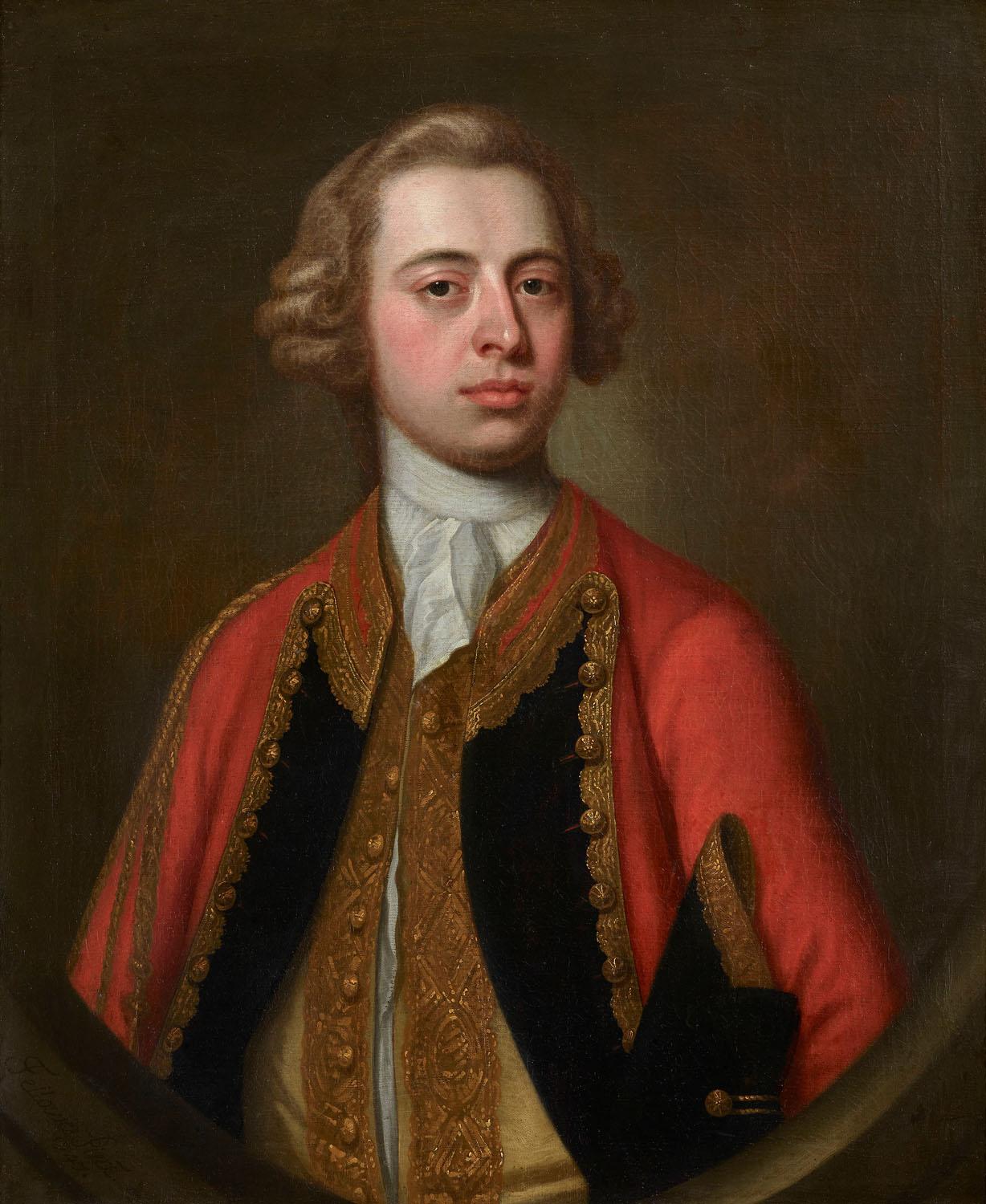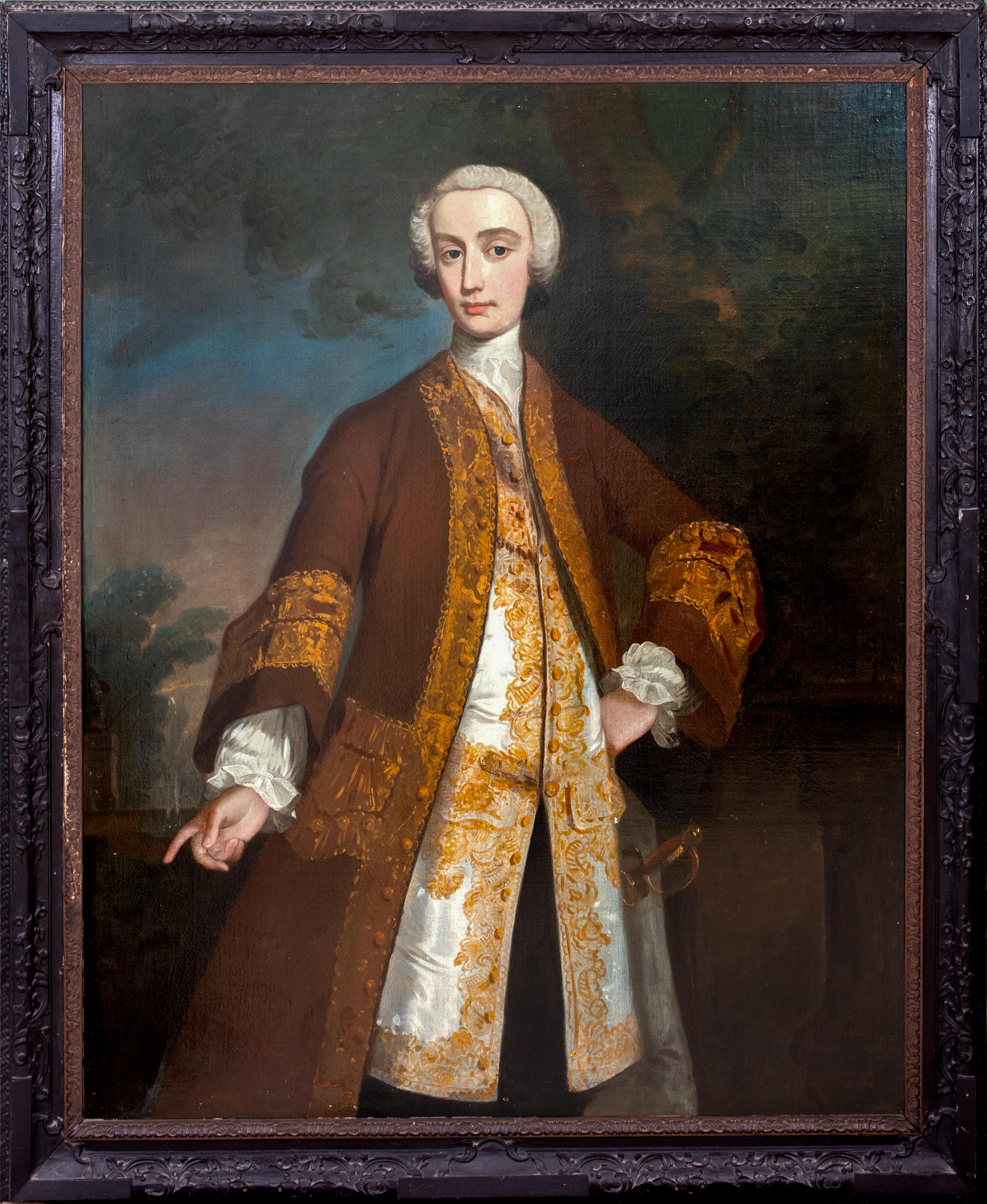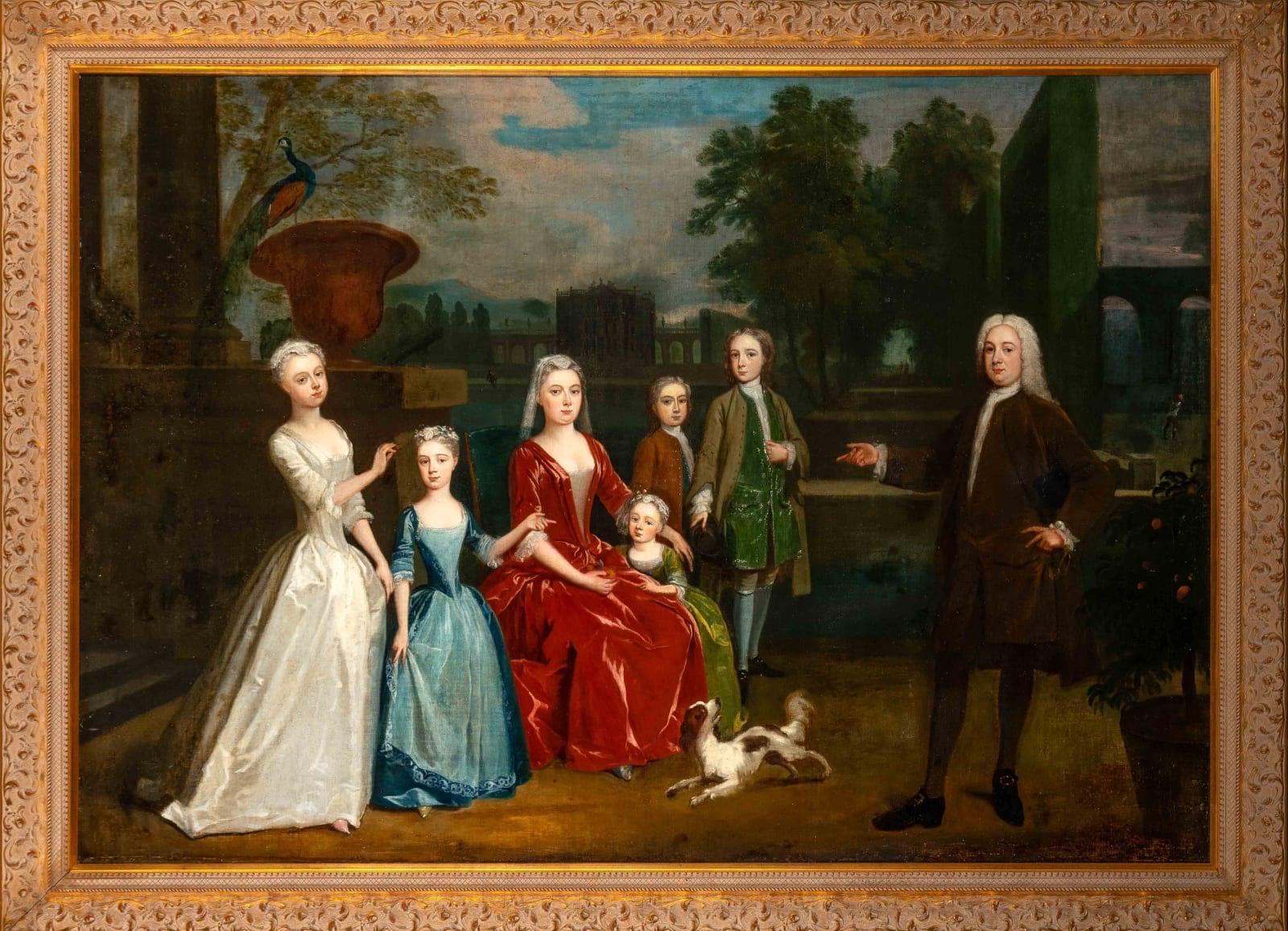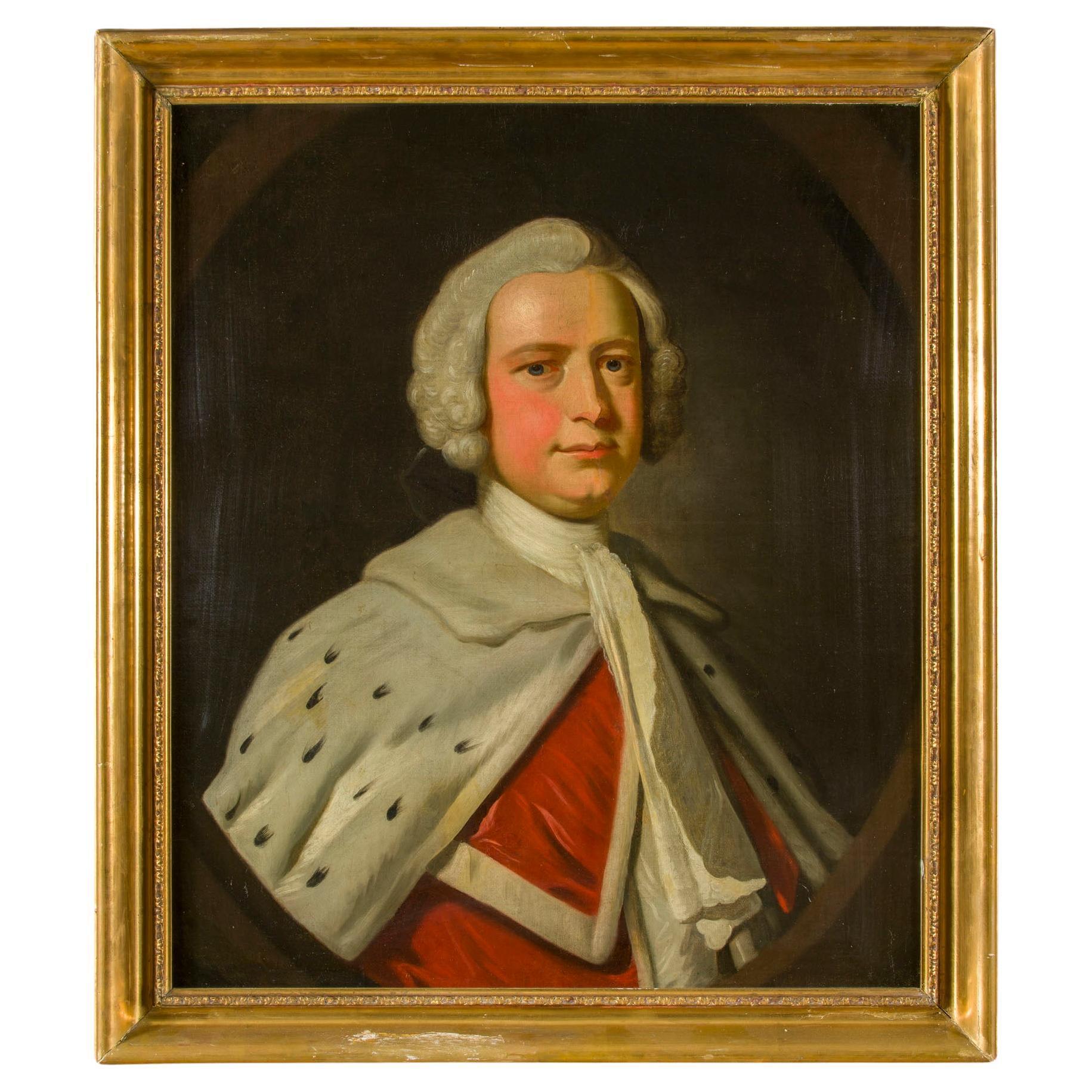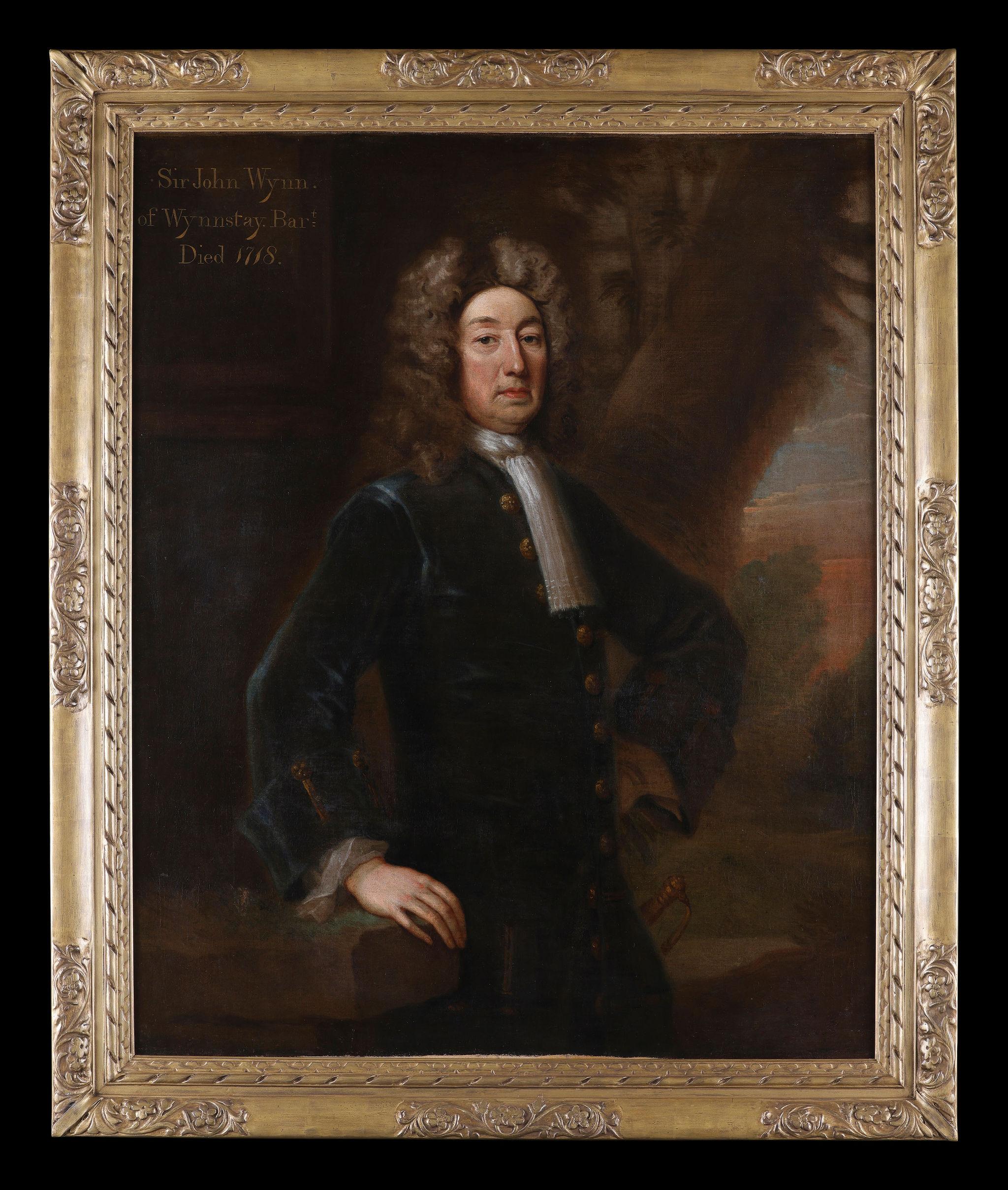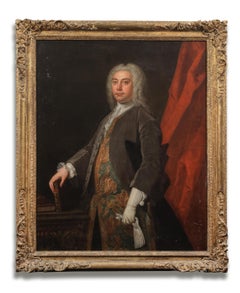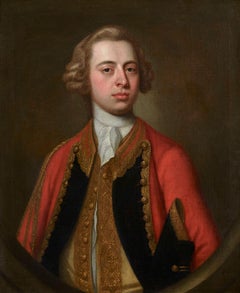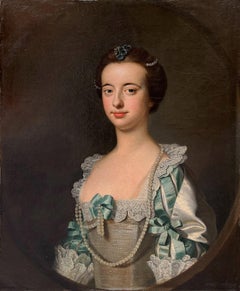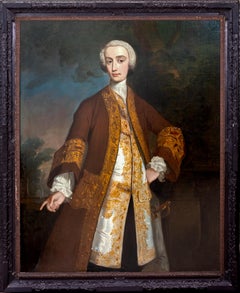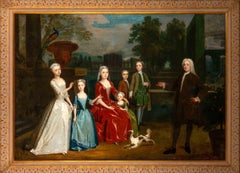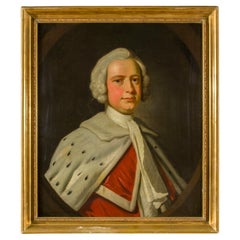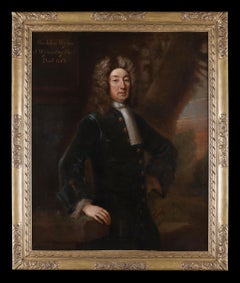Items Similar to William, 1st Viscount Bateman and Family
Want more images or videos?
Request additional images or videos from the seller
1 of 11
Gawen HamiltonWilliam, 1st Viscount Bateman and Family
$16,770.78
£12,200
€14,282.11
CA$23,422.90
A$25,402.70
CHF 13,342.46
MX$308,558.81
NOK 166,959.79
SEK 157,201.96
DKK 106,671.28
About the Item
Oil on canvas
Image size: 24 x 18 1/2 inches (61 x 47 cm)
Gilded wood framed
Provenance
Estate of Judge Davis Norton and Florence Edelstein.
William Bateman was a British Whig politician who sat in the House of Commons between 1721 and 1734. He was made Knight Companion of the Order of the Bath in 1732 and elected a Fellow of the Royal Society in 1733. This painting dates between 1732, when Viscount Bateman received his Order of the Bath, and 1737, when the artist Gawen Hamilton died.
The Order of the Bath is the fourth-most senior of the British Orders of Chivalry, after The Most Noble Order of the Garter, The Most Ancient. Here we can see Viscount Bateman sat wearing the insignia, accompanied by the figures of his wife Anne Spencer and his eldest son John.
In 1738 Anne discovered with horror that William had been conducting homosexual liaisons with some of the stable boys at one of his properties. She spent the rest of her life living with her brother after formally separating from her husband. William, who risked prosecution and social ostracism in England, subsequently lived abroad a good deal, although he does seem to have travelled back and forth between England and the Continent a fair bit. He died in Paris in 1744 and was succeeded in the viscountcy by his son.
- Creator:Gawen Hamilton (1697 - 1737, British)
- Dimensions:Height: 24 in (60.96 cm)Width: 18.5 in (46.99 cm)
- More Editions & Sizes:1 of 1Price: $16,771
- Medium:
- Period:
- Condition:
- Gallery Location:London, GB
- Reference Number:1stDibs: LU52411005532
About the Seller
5.0
Vetted Professional Seller
Every seller passes strict standards for authenticity and reliability
Established in 2007
1stDibs seller since 2014
84 sales on 1stDibs
Typical response time: 2 hours
- ShippingRetrieving quote...Shipping from: London, United Kingdom
- Return Policy
Authenticity Guarantee
In the unlikely event there’s an issue with an item’s authenticity, contact us within 1 year for a full refund. DetailsMoney-Back Guarantee
If your item is not as described, is damaged in transit, or does not arrive, contact us within 7 days for a full refund. Details24-Hour Cancellation
You have a 24-hour grace period in which to reconsider your purchase, with no questions asked.Vetted Professional Sellers
Our world-class sellers must adhere to strict standards for service and quality, maintaining the integrity of our listings.Price-Match Guarantee
If you find that a seller listed the same item for a lower price elsewhere, we’ll match it.Trusted Global Delivery
Our best-in-class carrier network provides specialized shipping options worldwide, including custom delivery.More From This Seller
View AllPortrait of Ralph William Grey
By Bartholomew Dandridge
Located in London, GB
Provenance
By descent through the sitter's family to
The Collection of R. W. Vivian-Neal of Poundisford Park, Somerset, from whom acquired by
With Lane Fine Art, UK, where purchased by the present owners in 1996
Literature
'Poundisford Park, Somerset' in Country Life, 22 December 1934, ill.
A.W. and C.M. Vivian-Neal, Poundisford Park, Somerset: A catalogue of pictures and furniture, Taunton 1939, cat. nos. 11 and 13
This is a three-quarter-length portrait of Ralph William Grey in a mole-coloured velvet coat and a long waistcoat of green satin, heavily embroidered in gold. Under his left right hand is a black chapeau bras. He has white doe-skin gauntlet gloves.
Son of William and Ann Grey of Backworth: born 19 December 1707. He married Mary the daughter of William Rawstorne of Newall in 1741 and died 5 November 1786. He was educated at Eaton and Trinity College, Oxford.
Within a year of his birth Mrs Grey died and, according to the Country Life article 'From that time forward all Mr Grey's faculties were concentrated on the well-being of his son. The possession of an heir gave zest to his efforts to build up the family fortune: he was successful in most of his ventures. Years later his interest in life was centred in the home of his daughter-in-law and grandchildren'.
Grey's right hand is depicted in the present portrait resting on Locke's Essays and the Country Life article also records that there are constant references to John Locke...
Category
Mid-18th Century English School Portrait Paintings
Materials
Oil
Portrait of William Henry Kerr, Earl of Ancram, 4th Marquess of Lothian
Located in London, GB
James Fellowes
Flourished 1719 - 1750
Portrait of William Henry Kerr, Earl of Ancram, 4th Marquess of Lothian
Oil on canvas, signed & dated 1747
Image size: 29 1/2 x 24 1/2 inches (75 x 62 cm)
Original gilt wood frame
William Henry Kerr was born a member of the Scottish peerage to William, third Marquess of Lothian, and his first wife Margaret, daughter of Sir Thomas Nicholson of Kemnay, first Baronet. William was styled Master Jedburgh until 1722, when his father was elevated to a Marquessate, after which he was referred to as Lord Jedburgh until 1735. Following his father’s military footsteps, on 20 June 1735 Ancram was commissioned as a cornet to the regiment (11th Dragoons) of his grand-uncle, Lord Mark Kerr. Ancram married Lady Caroline...
Category
1740s Old Masters Portrait Paintings
Materials
Oil
Portrait of a Gentleman
Located in London, GB
Oil on canvas
Image size: 17 x 23 1/2 inches (43 x 60 cm)
Contemporary William Kent hand made frame
Category
18th Century Portrait Paintings
Materials
Canvas, Oil
Portrait of Lady Mansfield of Ringwood
By Thomas Hudson
Located in London, GB
Portrait of Lady Mansfield of Ringwood
Oil on Canvas, unsigned
Image size: 25 x 30 inches (63 x 76 cm)
Original carved & gilded frame
Provenance
Descended through the Family Estate
Born in Poland in 1760 to the 2nd Earl of Mansfield and his wife, Elizabeth Mary Murray would later come under the care of her uncle, William Murray (1st Earl of Mansfield) at Kenwood House in Hampstead. David Murray (2nd Earl of Mansfield) was set to inherit the title and full wealth of his uncle, including Kenwood House. Lady Mansfield’s second cousin would soon join her at Kenwood, where they would be raised together and featured in multiple portraits of the time. Her younger sister, Henrietta, is seen in a separate portrait done by Thomas Hudson as well. At the age of 25 she married George Finch-Hatton, an English aristocrat and politician who sat in the House of Commons from 1772-1784.
Gazing out at the viewer, Lady Mansfield wears a decorated dress, with an abundance of pearls and lace, and a transparent gold lined veil surrounding her right shoulder. The excess of luxurious fabric matches another Hudson portrait of another Lady Mansfield, with the lace detailing and complementary bodice. The depiction of this Lady Mansfield epitomizes the style of portraiture in the 18th century, such as the styles Hudson’s pupils Joshua Reynolds, Joseph Wright, and Peter Toms. From Hudson’s travels to the Low Countries and Italy, he no doubt brought back artistic inspiration from the international pieces he encountered.
Thomas Hudson
Hudson was a celebrated 18th century portrait painter. Born in Devon in 1701 he studied under the artist Jonathan Richardson and married his daughter, against Richardson’s wishes.
He had many artistic friends including William Hogarth and Francis Hayman and travelled with them in Europe in 1748. He also visited Italy with the sculptor Louis-François Roubiliac in 1752. Hudson’s style of portraiture proved so successful that for a decade from 1745 to 1755 he was London’s most popular portrait painter and made a fortune painting the cream of London society and members of the Royal Family.
He was also a talented teacher, perhaps too good, as subsequently a number of his former assistants overtook him in popularity including the artist Joshua Reynolds.
Hudson retired in the late 1750’s and died in Twickenham in 1779. His most notable works include portraits of King George II and George Friedrich Handel and his “Portrait of a Nobleman in Van Dyck dress.” Many of Hudson’s works may be seen in art galleries. These include the National Portrait Gallery, the National Maritime Museum, the Tate Gallery, the Foundling Museum and the Bristol City Museum and Art Gallery. His works are also in Museums across the world...
Category
18th Century English School Paintings
Materials
Canvas, Oil
Portrait of Lady Mansfield of Ringwood
By Thomas Hudson
Located in London, GB
Portrait of Lady Mansfield of Ringwood
Oil on Canvas, unsigned
Image size: 25 x 30 inches (63 x 76 cm)
Original carved & gilded frame
Provenance
Descended through the Family Estate
...
Category
18th Century English School Paintings
Materials
Canvas, Oil
Portrait of a Gentleman, 18th Century Oil Painting
By Anton von Maron
Located in London, GB
Oil on canvas
Image size: 20 x 24 inches (51 x 61 cm)
Period gilt frame
This is a half-length portrait of a gentleman wearing a emerald coat and intricately designed waistcoat, dat...
Category
1760s Portrait Paintings
Materials
Canvas, Oil
You May Also Like
Portrait Of 1st Baron Hawkstone, Sir Rowland Hill, Tory MP for Lichfield
By Charles Jervas
Located in Blackwater, GB
Portrait Of 1st Baron Hawkstone, Sir Rowland Hill, Tory MP for Lichfield (1705-1783)
by Charles JERVAS (1675-1739)
Large 18th Century portrait of Baron Hawkstone, Sir Rowland Hill,...
Category
18th Century Portrait Paintings
Materials
Canvas, Oil
$12,096 Sale Price
20% Off
18th century painting of the Dalbiac family in the gardens of a country house
By Charles Philips
Located in Bath, Somerset
The painting depicts James (Jacques) Dalbiac, his wife Louise (ne de la Porte) and their five children, James, Charles, Louise, Marianne and Martha in the ornamental gardens of a grand country estate.
The extensive gardens extend into the distance with gardeners working in the background and figures strolling through the avenues of trees. A peacock and peahen can be seen on the wall to the left and a potted orange tree to the right. Louise Dalbiac holds an orange taken from the orange tree, aluding to the family's faith and their loyalty to the protestant King William of Orange and their adopted country.
The Dalbiacs were wealthy London silk and velvet merchants of French Huguenot origin who had fled France at the end of the 17th century to escape persecution for their protestant faith. England offered safe refuge and their skills and industriousness allowed them to establish one of the most successful businesses in London's Spitalfields which became a new centre of the silk trade, effectively leading to the collapse of the once dominant French silk industry. Both sons, James and Charles followed their father and Uncle into the family business, successfully growing the family's fortune and each going on to own their own country estates.
A conversation piece is a genre of painting used to describe group portraits of families and friends, often depicted with their servants and family pets and set within an elegantly furnished interior or the garden of a grand country house. They were a celebration of the intimacy of family relations as well as a sign of status, property and the power of succession. The informality of conversation pieces grew popular in 18th century England, allowing the sitters to present themselves in a more relaxed pose, perhaps engaged in intellectual conversation or showing their talents or interests. In this present portrait, the Dalbiacs are shown richly dressed and and at leisure in a grand country house setting, conveying their success and cultural and social aspirations.
Charles Philips (c.1703–1747) was an English artist known for painting a number of portraits and conversation pieces for noble and Royal patrons in the mid-eighteenth century. He was the son of portrait painter Richard Philips...
Category
Early 18th Century Old Masters Portrait Paintings
Materials
Canvas, Oil
Thomas Hudson Style 18th Century English Portrait
By Thomas Hudson
Located in Roma, IT
Important English school painting in the style of the great artist Thomas Hudson (Devonshire 1701 - Twickenham 1779)
It depicts the portrait of Harry Gray (1715-1768), 4th Earl of St...
Category
1750s Old Masters Portrait Paintings
Materials
Canvas, Oil
'Sir John Wynn, 5th Baronet' three-quarter-length portrait, oil on canvas
By John Vanderbank
Located in St. Albans, GB
Sir John Wynn, 5th Baronet
Canvas Size: 50 x 40" (127 x 102cm)
Outside Frame Size: 58 x 48" (147 x 122cm)
Sir John Wynn, 5th Baronet (1628 – 11 January ...
Category
1710s English School Portrait Paintings
Materials
Oil
Henry Bowles Howard, 12th Earl Of Suffolk And 5th Earl Of Berkshire
Located in New Orleans, LA
Sir Joshua Reynolds
1723-1792 British
Sir Henry Bowles Howard, 12th Earl of Suffolk and 5th Earl of Berkshire
Oil on canvas
Sir Joshua Reynolds is unequivocally considered the most important English portraitist of the 18th century who was instrumental in adapting the Grand Manner style in the portrait genre. In fact, when the Royal Academy was founded in 1768, Reynolds was elected its first President, setting the precedent of quality for which all other portraitists would strive.
Reynolds's portrait of Henry Bowles Howard, 12th Earl of Suffolk, showcases his genius in the genre and mastery over the medium. Reynolds’s portrait of the Earl expertly invokes classical values with strong lighting, rich colors and expert attention to detail to help underscore the prominence and revered echelon of the sitter. Howard was an esteemed British politician and Knight of the Garter. He served as Secretary of State for the Northern Department from 1771 to 1779, and he played a key role in utilizing mercenaries during the American Revolution and safeguarding Sweden's independence.
The portrait employs Reynolds's signature style to render Howard rightfully as a gentleman of distinction. Captured seated in a stately library, the Earl appears learned and austere as he places one hand upon a stack of important documents and looks wistfully into the distance. Reynolds makes these compositional choices decisively, as the seated position gives Howard a weighty appearance of importance and the semi-profile turn captures his countenance at an attractive angle that highlights his strong, masculine features. The work draws on the classical conventions of Greek and Roman art and the Italian Renaissance masters, anchoring the nobleman in a history of refinement. Everything from his strong yet welcoming expression to his pale face enlivened by a rush of blood to the cheeks presents the picture of a strong, vital and powerful leader.
As the first president of the Royal Academy in London, Reynolds’s commissions raised the status of an artist in Britain during the Romantic period and also established the portrait as an esteemed high art genre that garnered equal import to the history paintings that reigned supreme in decades prior. Today, Reynolds’s works grace the walls of the most important museums in the world, including the Louvre, the Metropolitan Museum of Art, and the National Gallery in London, among others.
Circa 1770
Canvas: 50 1/2" high x 40 1/4" wide
Framed: 61" high x 52 1/2" wide x 3 1/2" deep
Provenance:
Sir Henry Howard, 12th Earl of Suffolk and 5th Earl of Berkshire, 1739-1779
His mother, Lady Mary Howard, née Finch, Lady Andover, d. 1803
Acquired by descent to her daughter, Frances, and her husband Richard Bagot (later Howard)
Acquired by descent to their daughter, Mary (1784-1877), and her husband Col. Fulke Greville Upton (later Howard), d. 1846
Acquired by descent to Lieutenant Colonel H.R.G. Howard
Sale, Christie's, London, March 24, 1961, no. 29
Julius Weitzner, London and New York
Sale, Paris, Musée Galliéra, December 7, 1965, no. 165
Newhouse Galleries, New York, NY
Mr. and Mrs. F. Howard Walsh, Fort Worth, Texas, 1966
Walsh Family Art Trust
Private collection, Oregon
M.S. Rau, New Orleans
Exhibited:
British Institution, London, 1844, no. 130, loaned by the Hon. Fulke Greville Howard.
South Kensington, "Second special exhibition of National Portraits," 1867, no. 478, lent by the Hon. Mrs. Greville.
Agnew's, London, 1903, no. 17.
Literature:
Algernon Graves and W. V. Cronin, A History of the Works of Sir Joshua Reynolds, P.R.A., vol. 3 (London, 1899), p. 945.
David Mannings...
Category
18th Century Other Art Style Portrait Paintings
Materials
Canvas, Oil
Portrait of a Gentleman in a Landscape - British Old Master art oil painting
Located in Hagley, England
This superb British 18th century Old Master portrait oil painting is by William Williams of Norwich. It was painted circa 1780, after he had returned to England from in Philadelphia ...
Category
1780s Old Masters Portrait Paintings
Materials
Oil

